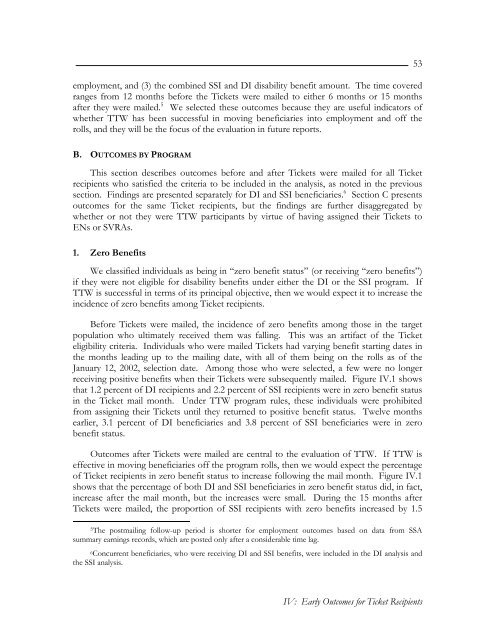Evaluation of the Ticket to Work Program, Implementation ...
Evaluation of the Ticket to Work Program, Implementation ...
Evaluation of the Ticket to Work Program, Implementation ...
You also want an ePaper? Increase the reach of your titles
YUMPU automatically turns print PDFs into web optimized ePapers that Google loves.
employment, and (3) <strong>the</strong> combined SSI and DI disability benefit amount. The time coveredranges from 12 months before <strong>the</strong> <strong>Ticket</strong>s were mailed <strong>to</strong> ei<strong>the</strong>r 6 months or 15 monthsafter <strong>the</strong>y were mailed. 5 We selected <strong>the</strong>se outcomes because <strong>the</strong>y are useful indica<strong>to</strong>rs <strong>of</strong>whe<strong>the</strong>r TTW has been successful in moving beneficiaries in<strong>to</strong> employment and <strong>of</strong>f <strong>the</strong>rolls, and <strong>the</strong>y will be <strong>the</strong> focus <strong>of</strong> <strong>the</strong> evaluation in future reports.53B. OUTCOMES BY PROGRAMThis section describes outcomes before and after <strong>Ticket</strong>s were mailed for all <strong>Ticket</strong>recipients who satisfied <strong>the</strong> criteria <strong>to</strong> be included in <strong>the</strong> analysis, as noted in <strong>the</strong> previoussection. Findings are presented separately for DI and SSI beneficiaries. 6 Section C presentsoutcomes for <strong>the</strong> same <strong>Ticket</strong> recipients, but <strong>the</strong> findings are fur<strong>the</strong>r disaggregated bywhe<strong>the</strong>r or not <strong>the</strong>y were TTW participants by virtue <strong>of</strong> having assigned <strong>the</strong>ir <strong>Ticket</strong>s <strong>to</strong>ENs or SVRAs.1. Zero BenefitsWe classified individuals as being in “zero benefit status” (or receiving “zero benefits”)if <strong>the</strong>y were not eligible for disability benefits under ei<strong>the</strong>r <strong>the</strong> DI or <strong>the</strong> SSI program. IfTTW is successful in terms <strong>of</strong> its principal objective, <strong>the</strong>n we would expect it <strong>to</strong> increase <strong>the</strong>incidence <strong>of</strong> zero benefits among <strong>Ticket</strong> recipients.Before <strong>Ticket</strong>s were mailed, <strong>the</strong> incidence <strong>of</strong> zero benefits among those in <strong>the</strong> targetpopulation who ultimately received <strong>the</strong>m was falling. This was an artifact <strong>of</strong> <strong>the</strong> <strong>Ticket</strong>eligibility criteria. Individuals who were mailed <strong>Ticket</strong>s had varying benefit starting dates in<strong>the</strong> months leading up <strong>to</strong> <strong>the</strong> mailing date, with all <strong>of</strong> <strong>the</strong>m being on <strong>the</strong> rolls as <strong>of</strong> <strong>the</strong>January 12, 2002, selection date. Among those who were selected, a few were no longerreceiving positive benefits when <strong>the</strong>ir <strong>Ticket</strong>s were subsequently mailed. Figure IV.1 showsthat 1.2 percent <strong>of</strong> DI recipients and 2.2 percent <strong>of</strong> SSI recipients were in zero benefit statusin <strong>the</strong> <strong>Ticket</strong> mail month. Under TTW program rules, <strong>the</strong>se individuals were prohibitedfrom assigning <strong>the</strong>ir <strong>Ticket</strong>s until <strong>the</strong>y returned <strong>to</strong> positive benefit status. Twelve monthsearlier, 3.1 percent <strong>of</strong> DI beneficiaries and 3.8 percent <strong>of</strong> SSI beneficiaries were in zerobenefit status.Outcomes after <strong>Ticket</strong>s were mailed are central <strong>to</strong> <strong>the</strong> evaluation <strong>of</strong> TTW. If TTW iseffective in moving beneficiaries <strong>of</strong>f <strong>the</strong> program rolls, <strong>the</strong>n we would expect <strong>the</strong> percentage<strong>of</strong> <strong>Ticket</strong> recipients in zero benefit status <strong>to</strong> increase following <strong>the</strong> mail month. Figure IV.1shows that <strong>the</strong> percentage <strong>of</strong> both DI and SSI beneficiaries in zero benefit status did, in fact,increase after <strong>the</strong> mail month, but <strong>the</strong> increases were small. During <strong>the</strong> 15 months after<strong>Ticket</strong>s were mailed, <strong>the</strong> proportion <strong>of</strong> SSI recipients with zero benefits increased by 1.55 The postmailing follow-up period is shorter for employment outcomes based on data from SSAsummary earnings records, which are posted only after a considerable time lag.6Concurrent beneficiaries, who were receiving DI and SSI benefits, were included in <strong>the</strong> DI analysis and<strong>the</strong> SSI analysis.IV: Early Outcomes for <strong>Ticket</strong> Recipients
















